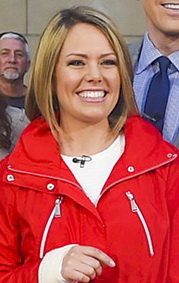Meteorologist Shares Struggle with Secondary Infertility
The term “infertility” is a common one that most people will recognize as the inability to conceive a child naturally. It’s a topic that was long taboo but one that more and more women (and men) are talking about in the hopes of spreading the word about just how prevalent a problem it is in the U.S. and around the world. These same people hope that they can also help in disseminating accurate information about infertility, its treatments, and the long struggle endured by so many who simply want to experience what they thought would come naturally to them.
But how about “secondary infertility”? What’s that all about and why is it necessary to talk about it?
 Many people are probably unfamiliar with the term secondary infertility. We can perhaps gander a guess as to what it means but, nonetheless, we probably haven’t read or heard much about it. But, as with infertility in general, more information about it is coming to the forefront of discussions.
Many people are probably unfamiliar with the term secondary infertility. We can perhaps gander a guess as to what it means but, nonetheless, we probably haven’t read or heard much about it. But, as with infertility in general, more information about it is coming to the forefront of discussions.
Secondary infertility refers to the inability to conceive a second child after conceiving one naturally. Women suffering with secondary infertility are less likely to talk about their journey because they feel as if they have no right to complain. After all, they were able to have one child, so isn’t it selfish of them to grumble about now being able to conceive another?
“Not at all,” says Today Show meteorologist, Dylan Dreyer, who recently opened up about her secondary infertility during a segment on the popular morning television show. “It’s a thing and something women shouldn’t be afraid to talk about,” she said in an Instagram post prior to Monday’s show.
Dreyer and her husband already have a toddler, Calvin, who’s two years old. When they started to try to give him a little or brother or sister, things just didn’t work, the popular meteorologist said. They later found out that her uterus was full of scar tissue from her emergency C-section with Calvin so it was removed and then she got pregnant right away. But she miscarried at 5 weeks. She was crushed.
Dreyer also found out that her egg count was much lower than it should have been at age 37, which was likely also contributing to her secondary infertility. In fact, most of the reasons why a woman can’t conceive in the first place are the same reasons another woman may not be able to conceive a second time around. These include ovulation disorders and sperm production problems that might not have been a factor for this particular couple when the first child was conceived.
And for women who are going through this, it’s just as stressful as primary infertility even though most are unwilling to admit it because they feel selfish. Nevertheless, it’s still an issue that will likely demand attention from a fertility specialist as well as support from one’s partner and family members.
“I am blessed with the family I have, but going through a miscarriage and not knowing what the future holds is emotional and I just want people to know that I am going through it, too,” said Dreyer at the end of her segment, adding that she hopes her opening up about the issue will prompt others to do the same.
Go back